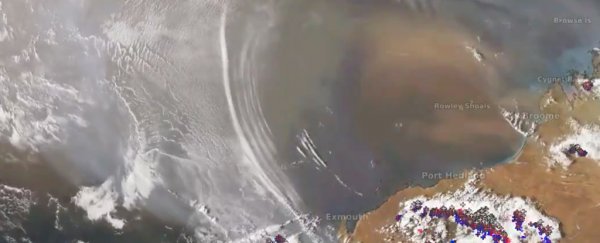The atmosphere is fluid. This means it's subject to fluid dynamics, such as circulation, currents, and, yes, gravity waves. The atmosphere is always in motion, so these phenomena happen all the time; but actually seeing them is another matter.
Well, thanks to weather satellites, now you can take a mighty gawk at atmospheric gravity waves that rippled out over Western Australia last week.
Not to be confused with gravitational waves, which are disturbances in the curvature of spacetime created by massive acceleration, gravity waves, also known as buoyancy waves, are a physical phenomenon where waves are generated in any fluid medium, such as waves at the beach, or ripples in a glass of water.
They also take place in gases, like our atmosphere, and are called gravity waves because gravity is the force that restores equilibrium.
In the atmosphere, they are generally created by obstructions to airflow, such as mountain ranges (on Venus, this creates enormous atmospheric waves), and by collisions between air masses of different temperatures.
The latter is what caused the waves over Western Australia.
"There was a big thunderstorm over the north-west of WA and the disturbance in this case was the cold air falling out of the thunderstorm and into the warmer air near the surface," meteorologist Adam Morgan of the Australian Bureau of Meteorology told the ABC.
"The difference in density there causes the disturbance and then the gravity wave can travel out as the cold air spreads out. The disturbance will exist until everything rebalances itself, that's why they can travel a long way."
In imagery from Japanese weather satellite Himawari-8 on Monday, 21 October, the waves can be seen moving outwards through the clouds across the Indian Ocean from north-west Australia. It's thanks to these clouds and the weather satellite that we can see the waves - unless there's something visible through which the waves can propagate, we can't see them, which is why the sight is so rare.
In the cavity left behind the waves, dust can also be seen spreading out across the Indian Ocean from the desert Pilbara region of Western Australia, where the winds generated by the thunderstorm whipped up a colossal dust storm.
